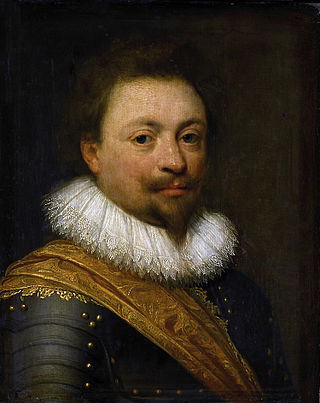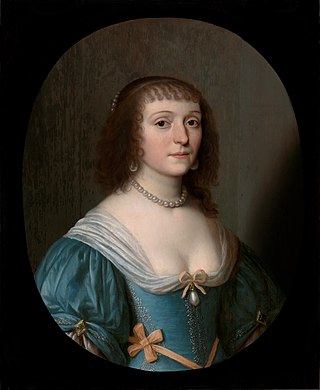
The Mauritshuis is an art museum in The Hague, Netherlands. The museum houses the Royal Cabinet of Paintings which consists of 854 objects, mostly Dutch Golden Age paintings. The collection contains works by Johannes Vermeer, Rembrandt van Rijn, Jan Steen, Paulus Potter, Frans Hals, Jacob van Ruisdael, Hans Holbein the Younger, and others. Originally, the 17th-century building was the residence of count John Maurice of Nassau. It is now the property of the government of the Netherlands and is listed in the top 100 Dutch heritage sites.

John Maurice of Nassau, called "the Brazilian" for his fruitful period as governor of Dutch Brazil, was Count and Prince of Nassau-Siegen. He served as Herrenmeister of the Order of Saint John from 1652 until his death in 1679.

Count John VII the Middle of Nassau-Siegen, German: Johann VII. der Mittlere Graf von Nassau-Siegen, official titles: Graf zu Nassau, Katzenelnbogen, Vianden und Diez, Herr zu Beilstein, was since 1606 Count of Nassau-Siegen, a part of the County of Nassau, and the progenitor of the House of Nassau-Siegen, a cadet branch of the Ottonian Line of the House of Nassau.

Dutch Brazil, also known as New Holland, was a colony of the Dutch Republic in the northeastern portion of modern-day Brazil, controlled from 1630 to 1654 during Dutch colonization of the Americas. The main cities of the colony were the capital Mauritsstad, Frederikstadt, Nieuw Amsterdam (Natal), Saint Louis, São Cristóvão, Fort Schoonenborch (Fortaleza), Sirinhaém, and Olinda.

Georg Marcgrave was a German naturalist and astronomer, whose posthumously published Historia Naturalis Brasiliae was a major contribution to early modern science.

Frans Janszoon Post was a painter during the Dutch Golden Age. He was the first European artist to paint landscapes of the Americas, during and after the period of Dutch Brazil. In 1636 he traveled to Dutch Brazil in northeast of South America at the invitation of the governor Johan Maurits van Nassau-Siegen. His works were widely collected in The Netherlands, Europe, and Brazil, with the works showing an idealized vision of Dutch colonial rule.

The Flag of New Holland, also known as the flag of Dutch Brazil, was the flag used by the Dutch West India Company for the territories that were under its control in Brazil from 1630 until 1654. In this period, Brazil was not granted its own flag, and only the flags of its colonizers or rulers were used.
Albert Eckhout (c.1610–1665) was a Dutch portrait and still life painter. Eckhout, the son of Albert Eckhourt and Marryen Roeleffs, was born in Groningen, but his training as an artist and early career are unknown. A majority of the works attributed to him are unsigned. He was among the first European artists to paint scenes from the New World. He was in the entourage of the Dutch governor-general of Brazil, Johan Maurits, Prince of Nassau-Siegen, who took him and fellow painter Frans Post to Dutch Brazil to have them record the country's landscape, inhabitants, flora and fauna. Eckhout is also famous for his still-life paintings of Brazilian fruits and vegetables. His paintings were intended for decoration in a domestic context.

Historia Naturalis Brasiliae, originally written in Latin, is the first scientific work on the natural history of Brazil, written by Dutch naturalist Willem Piso and containing research done by the German scientist Georg Marcgraf, published in 1648. The work includes observations made by the German naturalist H. Gralitzio, in addition to humanist Johannes de Laet. It was dedicated to Johan Maurits, Count of Nassau, who was the patron of the project during the period of Dutch rule in Brazil.

William, Count of Nassau-Siegen, German: Wilhelm Graf von Nassau-Siegen, official titles: Graf zu Nassau, Katzenelnbogen, Vianden und Diez, Herr zu Beilstein, was Count of Nassau-Siegen, a part of the County of Nassau from 1624 to 1642. A member of the House of Nassau-Siegen, a cadet branch of the Ottonian Line of the House of Nassau, he was a professional soldier who served in the armies of the Hanseatic League and the Republic of Venice, then with the Dutch States Army during the Eighty Years War. Promoted field marshal in 1633, he was successively governor of Emmerich, Heusden and Sluis.

The siege of Salvador was a siege that took place between April and May 1638, during the Dutch–Portuguese War and Eighty Years' War. The governor of the Dutch colony in Brazil, John Maurice, Prince of Nassau-Siegen, commanding the army of the Dutch West India Company, with vastly superior forces and a supporting fleet under Johan van der Mast, put the city of Salvador under siege. The Portuguese and Spanish defenders, commanded by Giovanni di San Felice, Count of Bagnolo, and Luís Barbalho, managed to resist the Dutch attacks until they gave up taking the city and withdrew with several casualties.

Prince George Frederick of Nassau-Siegen, German: Georg Friedrich Prinz von Nassau-Siegen, official titles: Prinz von Nassau, Graf zu Katzenelnbogen, Vianden und Diez, Herr zu Beilstein, was a count from the House of Nassau-Siegen, a cadet branch of the Ottonian Line of the House of Nassau. In 1664 he was elevated to the rank and title of prince. He served as an officer in the Dutch States Army, and was successively commander of Rheinberg and governor of Bergen op Zoom.

Princess Mauritia Eleonora of Portugal, Dutch: Prinses Mauritia Eleonora van Portugal, was a princess from the House of Aviz. As a close relative of Prince Frederick Henry of Orange, she spent a long time at his court in The Hague. Later in life she married a count from the House of Nassau-Siegen.

Black Woman with Child is a circa 1650 full-length portrait painting by Albert Eckhout. It is in the collection of the National Museum of Denmark, in Copenhagen.

The Recapture of Recife was a military engagement between the Portuguese forces under Francisco Barreto de Meneses and the Dutch forces of Captain Walter Van Loo. After the Dutch defeats at Guararapes, their surviving men, as well as other garrisons of New Holland, joined in the area of Recife (Mauritsstad) in order to make a last stand. However, after fierce fighting, the Portuguese victoriously entered the city and the remaining Dutch were ousted from Brazil.

Bartholomeus Eggers was a Flemish sculptor, who after training in his hometown Antwerp spent most of his active career in the Dutch Republic. Here he initially collaborated with other Flemish sculptors on the sculptural decorations for the new city hall in Amsterdam, a project which was under the direction of Artus Quellinus the Elder. He worked on various public projects and on commissions for leading courts in Europe. He is known for his portraits, funerary sculptures, reliefs, statues of children and allegorical, biblical and mythological sculptures. He was, together with Artus Quellinus the Elder and Rombout Verhulst, one of the leading sculptors active in the Dutch Republic in the second half of the 17th century.

Countess Anne Joanne of Nassau-Siegen, German: Anna Johanna Gräfin von Nassau-Siegen, official titles: Gräfin zu Nassau, Katzenelnbogen, Vianden und Diez, Frau zu Beilstein, was a countess from the House of Nassau-Siegen, a cadet branch of the Ottonian Line of the House of Nassau, and through marriage Lady of Brederode, Vianen, Ameide and Kloetinge.

Duchess Margaret of Schleswig-Holstein-Sonderburg, German: Margarethe Herzogin von Schleswig-Holstein-Sonderburg, official titles: Erbin zu Norwegen, Herzogin zu Schleswig, Holstein, Stormarn und der Dithmarschen, Gräfin zu Oldenburg und Delmenhorst), was a duchess from the House of Schleswig-Holstein-Sonderburg and through marriage Countess of Nassau-Siegen.

Brazil—Netherlands relations refers to the bilateral relationship between Brazil and the Netherlands. Brazil has an embassy in The Hague and a consulate in Amsterdam, and the Netherlands is represented by an embassy in Brasília and consulates in Belém, Belo Horizonte, Curitiba, Fortaleza, Manaus, Natal, Porto Alegre, Recife, Salvador, Rio de Janeiro, Santos, São Paulo and Vila Velha.

The Dutch-Kandyan War of 1670–1675 emerged as a result of territorial ambitions on the part of the Dutch, who sought to extend their dominion. The conflict saw French involvement, potentially at Rajasinha's invitation, although they were ultimately ousted. Consequently, the Dutch managed to expand their territorial holdings, successfully achieving their objectives.


















